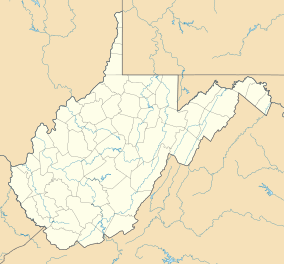Prickett's Fort State Park facts for kids
Quick facts for kids Prickett's Fort State Park |
|
|---|---|
|
IUCN Category III (Natural Monument)
|
|

Prickett's Fort reconstruction
|
|
| Location | Marion, West Virginia, United States |
| Area | 22 acres (8.9 ha) |
| Elevation | 971 ft (296 m) |
| Established | 1975 |
| Named for | Prickett's Fort |
| Governing body | West Virginia Division of Natural Resources |
|
Prickett Bay Boat Launching Site
|
|
| Location | Near Fairmont, West Virginia |
| Area | 216 acres (87 ha) |
| Built | 1773 |
| NRHP reference No. | 74002404 |
| Added to NRHP | February 13, 1974 |
Prickett's Fort State Park is a cool place in West Virginia that covers about 188 acres. It's located north of Fairmont, right where Prickett's Creek meets the Monongahela River. This park has a rebuilt fort that shows what life was like for early settlers in the late 1700s.
Contents
A Look Back at Prickett's Fort
Prickett's Fort was a very important place long ago. It was built to protect the first European settlers in what is now West Virginia. These settlers sometimes had conflicts with Native American groups. The fort helped keep families safe from attacks.
Why Was Prickett's Fort Built?
After a peace agreement in 1768, settlers moved into Native American lands. This led to more tension. In 1774, a conflict called Lord Dunmore's War started. This made all settlers in the Ohio River Valley feel unsafe. They needed places to go for protection.
To stay safe, settlers built many forts. One of these was on Jacob Prickett's land. Prickett's Fort was a simple log fence, about 100 feet square, built around Prickett's house. Native Americans usually avoided attacking these strong forts. They preferred to ambush smaller groups of people working outside.
Life Inside the Fort
When settlers felt they were in danger, families would gather at these forts. This was called "forting up." In 1774, there were at least a hundred such forts in the Monongahela Valley. Many were close to Prickett's Fort.
During dangerous times, as many as eighty families, hundreds of people, would stay at Prickett's Fort. They might stay for days or even weeks. Even though militiamen from the area were attacked elsewhere, Prickett's Fort itself was never attacked.
Rebuilding History: Prickett's Fort Today
The last time Prickett's Fort was mentioned in writing was in 1780. Many years later, in 1916, a monument was put up to honor the settlers who built it. In 1973, the original fort site was almost covered by a new parking lot.
How the Fort Was Reconstructed
To save the fort's history, the Marion County Historical Society created a group called the Prickett's Fort Memorial Foundation. They decided to rebuild the fort. They found that the original fort site was likely destroyed when a railroad bridge was built in 1905.
So, the Foundation chose a small hill overlooking the river for the new fort. They used old buildings donated to the project to get wood for the reconstruction. The new fort was designed based on a description from Stephen Morgan, an early settler's son.
The fort you see today is 110 feet square. It has two-story blockhouses at each corner. Inside, there are fourteen small cabins along the walls. There is also a meeting house and a store house in the middle. The Foundation admits the rebuilt fort is "much more elaborate" than the original. However, they say all its features could have been found at some fort in the region.
What You Can See at the Fort
At the reconstructed fort, you can see people demonstrating 18th-century crafts. These include carpentry, blacksmithing, and spinning. It's like stepping back in time!
There's also a visitor center managed by the Foundation. It has a research library, a gift shop, and a gallery. You can watch a video there to learn more about the fort's history.
Fun Things to Do at the Park
Prickett's Fort State Park offers lots of fun activities for visitors. It's a great place to learn and explore.
Exploring the Job Prickett House
Just south of the fort, you can visit the Job Prickett House. This house was built in 1859 by Jacob Prickett's great-grandson. It shows what a typical 19th-century farmhouse looked like. You can see original furniture and tools inside. This house is even listed on the National Register of Historic Places.
Outdoor Adventures and Shows
The park has a large outdoor amphitheater with 400 seats. The Fairmont State University theater department uses it every summer for musicals and plays. You can also enjoy picnic areas and nature trails. There's even a boat launch if you want to get out on the water.
Prickett's Fort State Park connects to two trails. You can walk or bike on the MCPARC trail to Fairmont. Or you can take the Mon River Trail to Morgantown. Most parts of the park are also easy to access for people with disabilities.
More to Explore
- Jacob Prickett, Jr. Log House
- List of West Virginia state parks
- State park



